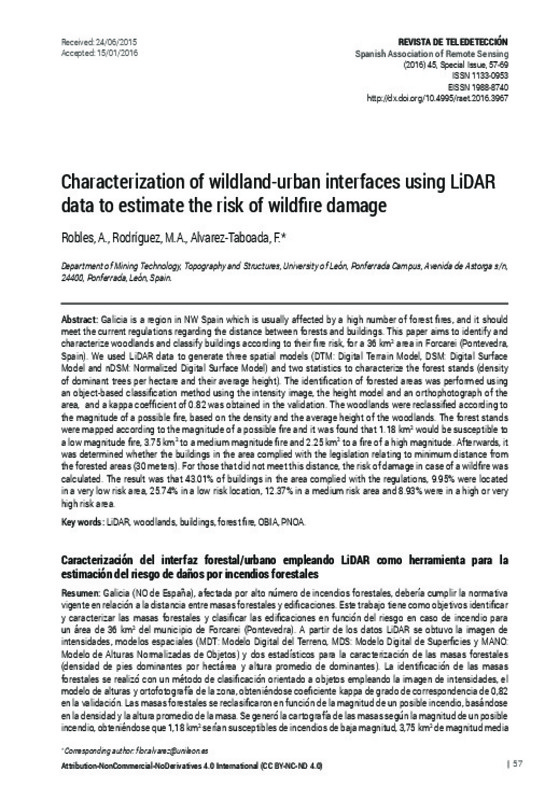|
Resumen:
|
[EN] Galicia is a region in NW Spain which is usually affected by a high number of forest fires, and it should meet the current regulations regarding the distance between forests and buildings. This paper aims to identify ...[+]
[EN] Galicia is a region in NW Spain which is usually affected by a high number of forest fires, and it should meet the current regulations regarding the distance between forests and buildings. This paper aims to identify and characterize woodlands and classify buildings according to their fire risk, for a 36 km2 area in Forcarei (Pontevedra, Spain). We used LiDAR data to generate three spatial models (DTM: Digital Terrain Model, DSM: Digital Surface Model and nDSM: Normalized Digital Surface Model) and two statistics to characterize the forest stands (density of dominant trees per hectare and their average height). The identification of forested areas was performed using an object-based classification method using the intensity image, the height model and an orthophotograph of the area, and a kappa coefficient of 0.82 was obtained in the validation. The woodlands were reclassified according to the magnitude of a possible fire, based on the density and the average height of the woodlands. The forest stands were mapped according to the magnitude of a possible fire and it was found that 1.18 km2 would be susceptible to a low magnitude fire, 3.75 km2 to a medium magnitude fire and 2.25 km2 to a fire of a high magnitude. Afterwards, it was determined whether the buildings in the area complied with the legislation relating to minimum distance from the forested areas (30 meters). For those that did not meet this distance, the risk of damage in case of a wildfire was calculated. The result was that 43.01% of buildings in the area complied with the regulations, 9.95% were located in a very low risk area, 25.74% in a low risk location, 12.37% in a medium risk area and 8.93% were in a high or very high risk area.
[-]
[ES] Galicia (NO de España), afectada por alto número de incendios forestales, debería cumplir la normativa vigente en relación a la distancia entre masas forestales y edificaciones. Este trabajo tiene como objetivos ...[+]
[ES] Galicia (NO de España), afectada por alto número de incendios forestales, debería cumplir la normativa vigente en relación a la distancia entre masas forestales y edificaciones. Este trabajo tiene como objetivos identificar y caracterizar las masas forestales y clasificar las edificaciones en función del riesgo en caso de incendio para un área de 36 km2 del municipio de Forcarei (Pontevedra). A partir de los datos LiDAR se obtuvo la imagen de intensidades, modelos espaciales (MDT: Modelo Digital del Terreno, MDS: Modelo Digital de Superficies y MANO: Modelo de Alturas Normalizadas de Objetos) y dos estadísticos para la caracterización de las masas forestales (densidad de pies dominantes por hectárea y altura promedio de dominantes). La identificación de las masas forestales se realizó con un método de clasificación orientado a objetos empleando la imagen de intensidades, el modelo de alturas y ortofotografía de la zona, obteniéndose coeficiente kappa de grado de correspondencia de 0,82 en la validación. Las masas forestales se reclasificaron en función de la magnitud de un posible incendio, basándose en la densidad y la altura promedio de la masa. Se generó la cartografía de las masas según la magnitud de un posible incendio, obteniéndose que 1,18 km2 serían susceptibles de incendios de baja magnitud, 3,75 km2 de magnitud media y 2,25 km2 de elevada. Se determinó si las edificaciones de la zona cumplían la legislación relativa a los 30 metros de distancia mínima a la masa forestal, clasificando el riesgo de daños de aquellas que no cumplían en caso de incendio forestal. El resultado fue que el 43,01% de las edificaciones cumplía la normativa, el 9,95% situación de riesgo muy bajo, el 25,74% en riesgo bajo, el 12,37% en medio y que el 8,93% estaba en una situación de riesgo alto o muy alto
[-]
|








